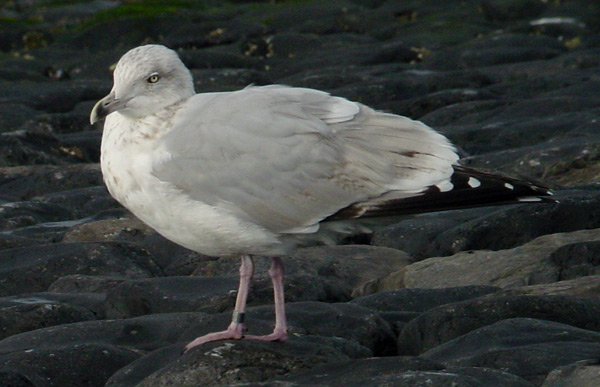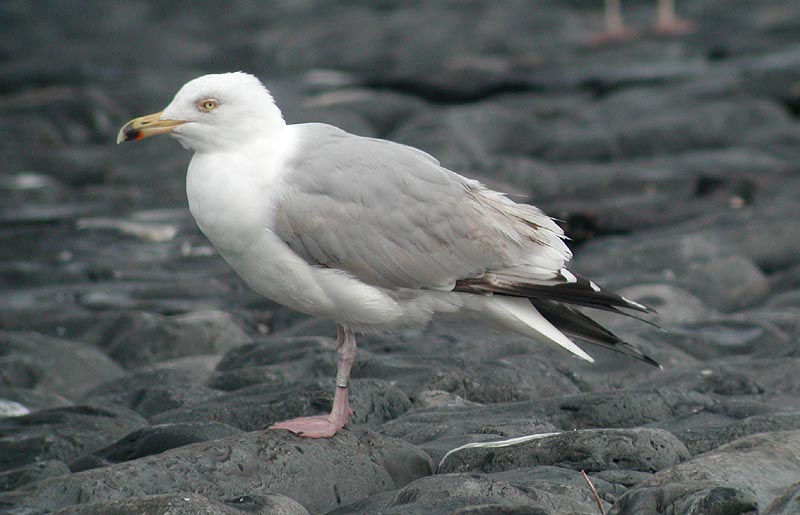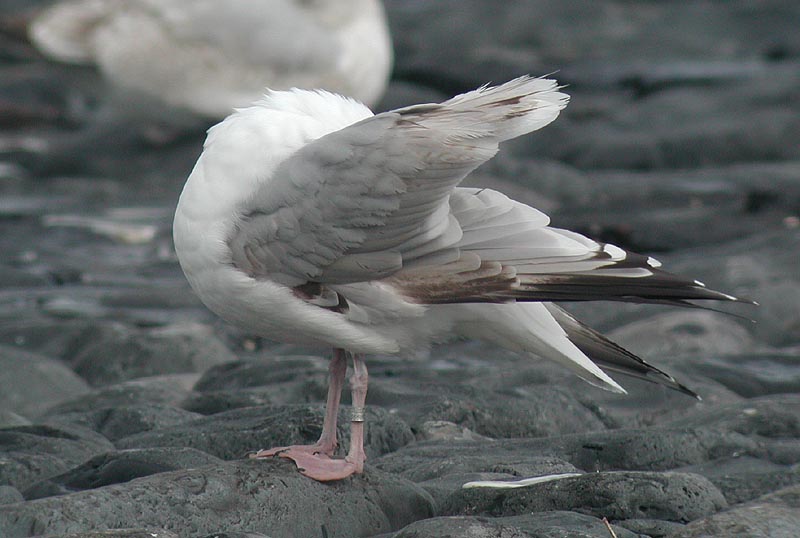 Herring
Gull - Zilvermeeuw (argentatus & argenteus): sub-adult March
Herring
Gull - Zilvermeeuw (argentatus & argenteus): sub-adult March
(last update: 24 maart 2005)
Home
Links
to Gull Sites
Gull Taxa
Gull Topography
Grey & Colour Charts
Locations in NW Europe
Summaries of Articles
About ORG
@
Herring Gull 5.366.547 4-5cy (argenteus), 2003-2004, Westkapelle, the Netherlands (51.32N 03.26E). Pictures Pim Wolf.
below: 4cy 5.366.547 (argenteus), November 15 2003, Westkapelle, the Netherlands.
A bird with a Dutch ring: Arnhem 5.366.547. Ringed on 14 September 2001 as 2cy at Nieuwdorp (Landfill), Zeeland (51.27N 03.43E). Primaries, secondaries and rectrices fully grown. Most of the greater and lesser coverts show an obvious brown hue and are worn at the fringes; the median coverts look fresher and are replaced again in the partial moult this autumn. They appear grey now.
From June to October, sub-adult Herring
Gull have a complete moult to so-called "adult winter" plumage.
As long as the old outer third generation primaries are visible (until
August), ageing as 4cy is rather straightforward. From November onwards,
4cy birds much resemble adult birds, except that the bare parts still show
immature features: the black bill-band is obvious, extending over both
upper and lower mandible. On average, this plumage develops a more
pronounced winter 'hood' than in full adults: dense streaking on head,
especially around the eye and in the hind-neck. The upper-parts,
wing-coverts and tertials appear adult-like grey from 4cy October onwards.
The fourth generation tail-feathers are plain white.
The new fourth generation primaries are similar to the adult primaries,
although the primary tips may appear slightly smaller, but otherwise
similar in pattern: grey inner-wing and black outer-wing. Both P9 and P10
show a mirror. P5 shows small black sub-terminal markings in argenteus,
concentrated on the outer-web as a clear-cut black angular spot and rarely
extending on the inner-web as a diffuse streak. There may be some black on
P4 as well. Adult argenteus show a different pattern in the outer
primaries, compared to northern argentatus. In argentatus,
especially from northern Scandinavia, the black marking on P5 is very
limited and diffuse or this is sub-terminal markings are completely
lacking on P5.
Argenteus has more black in the outer primaries, including a black
band on the top of p10 in most birds, dividing the tip from the mirror. If
the black sub-terminal band on P10 is broken, the outer-web of p10 still
shows black marking. Argentatus normally lacks sub-terminal
markings on the outer-web of P10.
The scapular coverts are plain grey, lacking white crescents. The tertials
show obvious white tips. The iris is yellow. The bill is yellow with a red
gonydeal spot confined to the lower mandible. The orbital ring is
yellow-orange or orange-red. The legs are flesh-pink.

below: 5.366.547 5cy (argenteus), March 29 2004, Westkapelle, the Netherlands. Pictures Pim Wolf.

This is clearly a sub-adult Herring Gull,
ringed at Nieuwdorp dump, the Netherlands (51.27N 03.43E) on September 19
2001 (then 2cy bird). It's a regular bird in winter at Westkapelle,
Zeedijk, where it was photographed by Pim Wolf. The scapulars are completely adult-like grey
while a few wing-coverts and the upper tertials show some dark-centrd feathers. Note
also the brown hue on the greater primary
coverts and the extensive black on the bill.
The fourth generation primaries are similar to the adult primaries,
although the primary tips may appear slightly smaller, but otherwise
similar in pattern: grey inner-wing and black outer-wing. Both P9 and P10
may show a mirror. P5 has small black sub-terminal markings,
sometimes reduced to the outer-web as a clear-cut black angular spot, but
sub-adult birds may also show dark on the inner-web (sometimes as a
diffuse streak). There may be some black on P4 as well in sub-adults.
Adult argenteus show a different pattern in the outer primaries,
compared to northern argentatus. In argentatus, especially
from northern Scandinavia, the black marking on P5 is very limited and
diffuse or this is sub-terminal markings are completely lacking on P5. Argenteus
has more black in the outer primaries, including a black band on the top
of p10 in most birds, dividing the tip from the mirror. If the black
sub-terminal band on P10 is broken, the outer-web of p10 still shows black
marking. Argentatus normally lacks sub-terminal markings on the
outer-web of P10.
In sub-adult argenteus, the scapular coverts are plain grey,
lacking white crescents. The tertials show obvious white tips. The iris is
yellow. The bill is yellow with a red gonydeal spot confined to the lower
mandible. The orbital ring is yellow-orange or orange-red. The legs are
flesh-pink.
